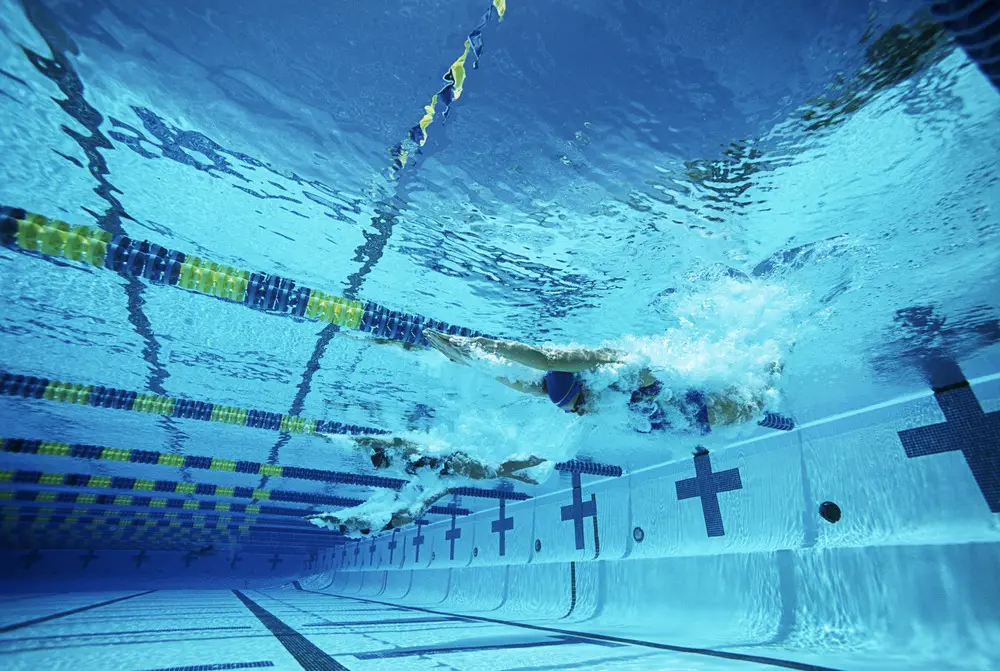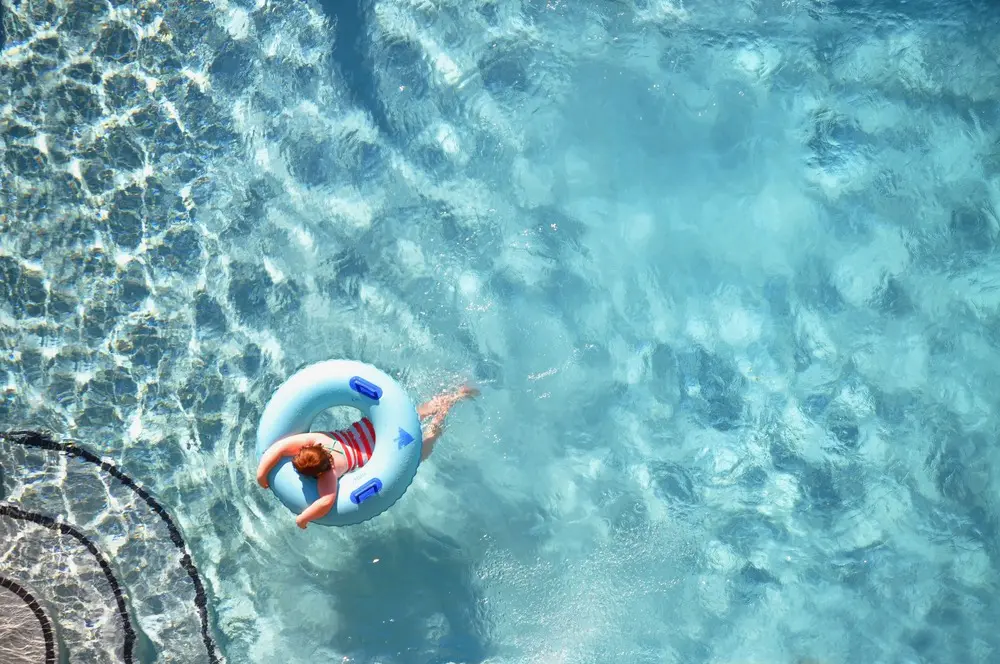For any pool operator or construction company, ensuring the correct pool depth is a crucial part of the design and installation process. The depth of your pool will have an impact on the overall design, on the functionality of the pool and on the safety and comfort of the end users. Moreover, competitive pools such as Olympic pools need to conform to specific guidelines set by World Aquatics (former FINA) Facilities Rules.
In this article, we’ll see the essentials on pool depth, including its role in designing the pool, the correct depth for various types of competition pools as well as the guidelines for leisure pools.
Dive deeper with the eBook
The importance of the right pool depth
Designing a swimming pool needs to take into account multiple aspects related to the feasibility, durability, and safety of the pool. In terms of spatial configuration, the depth of the pool is one of the key elements that influences all subsequent construction and usage of the facility.
Commercial pools need to meet specific requirements and recommendations, based on safety considerations. Furthermore, pools designed to host competitive events need to conform to international standards, while also ensuring complete safety measures for the athletes swimming in them.

Measuring the pool depth
The depth of a pool is calculated by measuring the distance between the water level and the pool floor. Depending on the shape and size of the pool, its intended use, and local codes and building regulations, this depth can vary within the parameters explained below.
Pool depth can also vary within the same pool. This is the case where designs include a shallow end – allowing for gradual immersion of swimmers into the water. Most leisure pools include a shallow and a deep end, with the depth of the pool increasing gradually from one end to the other.
Pool depth according to its use
Depending on the intended use of a facility, pool depth can vary significantly. However, whether the swimming pool is designed for a sports club, for daily workouts or for official competitions, pool depth is always a factor that needs to be considered. In all cases, there is one big difference: between pools intended for official competition events and pools for leisure and workout use.
Pools intended for competition events must strictly comply with World Aquatics design regulations, which also include the depth of these pools. For leisure and workout ones, while dimensions are recommended, they are not mandatory.
Standard pool depths for competition facilities
Olympic and semi-Olympic swimming pools
These are normally found in big sports clubs and in facilities built to host official swimming competitions. For Olympic pools, the mandatory length is 50 metres, while semi-Olympic pools are 25 metres long. Both have a mandatory minimum depth of 1.35 metres. This depth needs to be met along the first metre to 6 metres from the end wall, while the rest of the length of the pool can be 1 metre deep (but no less).
When pools host the Olympic Games or World Championships, they need to comply with a depth of 2 metres minimum . It is now recommended that these pools are actually 3 metres deep, since the deeper the water, the less rebound is felt when swimming and the surface of the water becomes more stable. If the pool also hosts other disciplines (such as artistic swimming), a depth of 3 metres is also recommended.
Diving pools and high-diving pools
For diving, athletes need a big height to jump from (5, 7.5 or 10 metres). This is why diving pools tend to be found in purpose-built sports complexes and specialised high-performance sports clubs.
Diving pools must be at least 5 metres deep . For high diving , where athletes jump in from 20 metres (women) or 27 metres (men) above the water, the depth increases to 5.8 metres . It’s important to note, however, that there are legacy pools built before December 2017 which are 5 metres deep and have been allowed to continue to host high diving competitions.
Water polo pools
In most cases, water polo is played in Olympic swimming pools that have been adapted to host the competition by using ropes to mark out the field size and adding relevant accessories for the game. The key pool depth consideration in this case is that players can never touch the bottom of the pool. Thus, the minimum depth of a water polo pool is 1.8 metres.
During the Olympics or for World Championship events, a minimum of 2 metres depth is mandatory for hosting water polo matches.
Artistic swimming pools
For the routine section of artistic swimming competitions, the pool needs to allow a minimum area of 15 by 25 metres in which the swimmers perform. A section of 12 x 12 metres within this must be at least 3 metres deep . For the rest of the surface area, the depth can be 2 metres minimum.
The depth at the pool wall is required to be 2 metres, with a slope to reach the section where 3 metres is required. The 3 metres depth must be reached within 1.2 metres from the pool wall. During the Olympics and World Championships , all artistic swimming pools (including for warm-ups) must be 3 metres deep .
Open water swimming
Open water swimmers perform outdoors, usually in oceans or the sea, lakes, or rivers, along a marked out route. Despite this activity being in nature, there is still a requirement to measure the depth of the water along the route. At any point, this needs to be at least 1.4 metre (including for Olympics and World Championships events).

Pool depths for leisure pools
Leisure pools are those swimming pools found in sports clubs (used for workouts and general fitness purposes), municipal centres, spas, wellness centres, water parks and hotels or resorts.
These do not need to adhere to specific pool depth rules and can be customised to fit in with a theme, the overall design, or space constraints. However, there are recommendations according to what pool depth constructors should design to, in order to ensure comfort and enjoyment for the end users.
- Large leisure or recreational pools such as those found in sports centres and hotels or resorts have a family-friendly approach, looking to meet the needs of all types of users. This is why they feature a slope from a shallow end to a deeper end. This usually ranges from 0.5 metres to 2.5 metres in the deepest section of the pool.
- Swimming pools in sports clubs , also known as lap pools, are generally between 1 and 3 metres in depth.
- Pools in wellness centres and spas are usually shallower. You can find vitality and hydromassage pools which are usually no deeper than 1.2 metres. These are generally designed for sitting around the edges.
- For hot tubs and cold plunge pools, the usual recommended depth is of 1 metre. This allows people to immerse themselves in the water in a safe manner.
- Finally, water parks feature pools mainly designed for children , so the depth will take into account their safety first and foremost. While pools with water slides need to be deeper, most water parks pools are only about 0.3 to 0.6 metres deep. Even splash parks have no depth at all – with soft bottom materials and overflow channels that collect the water splashed around, they feature interactive fountains and water jets, so they are not focused on immersion in the water.
Pool depths vary widely
While it’s true that there are recommendations as well as strict requirements for swimming pools and associated water features, ultimately, the depth of a pool can vary widely from one design to another.
The first important consideration when building a swimming pool is, of course, safety. As long as your pool depth meets this requirement, you can then take inspiration from leisure pools and other similar facilities for your own pool design. Or adhere to World Aquatics (former FINA) restrictions if you plan to host official events.
